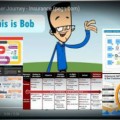The core of every business organisation’s mission is to answer customer needs. In order to do so you must first identify and understand them.
Understanding your customers’ needs is essential but superficial knowledge is not enough to ensure your organisation’s profitability. To achieve product/market fit, the point where you answer needs better than your competitors, you must get to a deeper level of understanding of those needs.
Benefits of understanding customer needs
An added bonus to mastering customer needs (and providing a solution that fulfills them) is that every marketing dollar spent will yield higher returns than those of your competitors, who don’t have the same depth of knowledge.
A deeper level of understanding your customers’ needs will also ensure an overall better customer experience, which we already saw in a previous post on the customer experience journey, leads to higher profitability.
Ok, so now that you are convinced understanding customer needs is in your organisation’s best interest, the question you may be asking is how to go about mastering them.
First you have to identify the needs you will be fulfilling (hint; don’t stop at the needs attached directly to your product/service, also look at the ones surrounding the entire customer experience). Once you have zoomed in on the needs to fulfill, you must not only understand the needs but the whole story around them.[1] This process requires lots of effort, time and knowledge of data gathering techniques. It isn’t as straightforward as it may seem.
As a marketer a huge part of my role, aside from finding the right customers, is to identify and understand their needs. Over the years, I learned that there are three steps to any quest aiming to either identify or understand customers’ needs.
Those steps are; Listen, observe, and empathise
Listen
 The very first thing you should do when you have a business idea is to talk informally with potential customers. This mostly means listen to their answers. It also helps you figure out who your early adopters are. If it’s not possible for you to talk directly to potential customers, find people who know your potential customers inside out, and talk with them.
The very first thing you should do when you have a business idea is to talk informally with potential customers. This mostly means listen to their answers. It also helps you figure out who your early adopters are. If it’s not possible for you to talk directly to potential customers, find people who know your potential customers inside out, and talk with them.
Don’t forget to set objectives for your conversation. Examples of conversation objectives are; to see whether the needs you think exist actually do, how they are being filled and the relative importance of those needs. In order to maximise the amount of information you take in, not only do you have to limit how much talking you will do, but you need the proper mindset. Your mind should be open and devoid of as many filters as possible. Always remember that explaining your project in length and your view of the world is just taking time away from achieving your goal. Listen.
Please do not let the fear of someone stealing your business idea prevent you from engaging with potential customers.
Observe
 Observation is essential to identify less obvious needs and understand all pertinent customer needs at a deeper level. Asking potential customers won’t yield the information you seek because people don’t or can’t always tell you the truth.
Observation is essential to identify less obvious needs and understand all pertinent customer needs at a deeper level. Asking potential customers won’t yield the information you seek because people don’t or can’t always tell you the truth.
There are many categories of observation techniques.
Natural observation
Natural observation techniques allow you to observe your potential customers while they are naturally fulfilling the needs you want to address. Ideally, without them noticing you too much so their behaviours are not altered.
Such observation experiments will yield huge amounts of customer knowledge. Hence you need to ensure you set observation goals for your experiments. Your observation goals can pertain not only to your subjects’ actions but also their interactions, environments, and the tools they use.
You will most likely need to repeat such experiments many times to take in all the knowledge you will need. Alternatively, you can task multiple people to observe the same situation while giving them different observation goals.
Two of my favorite natural observation techniques are shadowing and A day in the life.[2]
Directed observation
These techniques are associated with a goal of understanding a specific thought process or behaviour in a given circumstance.
They require putting the customer in a specific situation or assigning him, or her, a task and then observing. This can be followed by a question period to help interpret what you observed. It can be done face to face, remotely with cameras or on the web (such as A/B testing).
Third person observation
This technique is used in addition to one of the previous ones where the observer is someone who has a vision of the world that is significantly different from you or anyone in your industry. This technique yields much richer interpretation/insights from the data you collect.
Empathise
 Whenever possible, put yourself in your customers’ shoes or, even better; take the time to get to know some of your favorite customers personally. This will enable a relationship of trust and maybe even friendship (personal bonus for you) to develop over time.
Whenever possible, put yourself in your customers’ shoes or, even better; take the time to get to know some of your favorite customers personally. This will enable a relationship of trust and maybe even friendship (personal bonus for you) to develop over time.
Get involved in activities or causes your customers are passionate about. This will give you an even deeper understanding of their values and what is important to them.
Sharing your customers’ values is a requirement to attract them into your community. If you are unsure of what I am referring to here, see this previous post on community marketing.
The 360 view of customer needs
 Applying all of these techniques to understand your customers’ needs is required to get a 360 degree view of them. Using many different perspectives to master your customers’ needs will yield rich and actionable information. It will also facilitate innovation in your organisation.
Applying all of these techniques to understand your customers’ needs is required to get a 360 degree view of them. Using many different perspectives to master your customers’ needs will yield rich and actionable information. It will also facilitate innovation in your organisation.
Customer Feedback Flow
 Striving to understand customer needs is a continuous process. Set up processes and assign resources in your organisation to make it an integral part of your business activities.
Striving to understand customer needs is a continuous process. Set up processes and assign resources in your organisation to make it an integral part of your business activities.
These processes can be as simple as a quick questionnaire you send out on a regular basis, or an automatic feedback one, after a certain task is completed. Analytics reports, comments on social medias summaries or a managed (live or online) community feedback or observation reports are all valid continuous feedback processes that can yield precious information on your customers’ needs.
Be aware that this feedback is highly valuable to your organisation, if you act on it. Hence, reward your customers adequately (often a simple thank you is enough) for sharing their thoughts and concerns.
Mastering the understanding of customer needs is no small task. Your rewards for listening, observing and empathising with your customers, will be a tighter product/market fit, greater customer satisfaction and higher profitability.
[1] Needs are always dependant other factors. E.g. The need for a given medicine will be dependant on experiencing specific symptoms at a level that requires relief and not being allergic or prone to adverse effects to said medicine.
[2] The following book describes these techniques : This is Service Design Thinking – M. Stickdorn, J. Schneider et al. – John Wiley & Son










